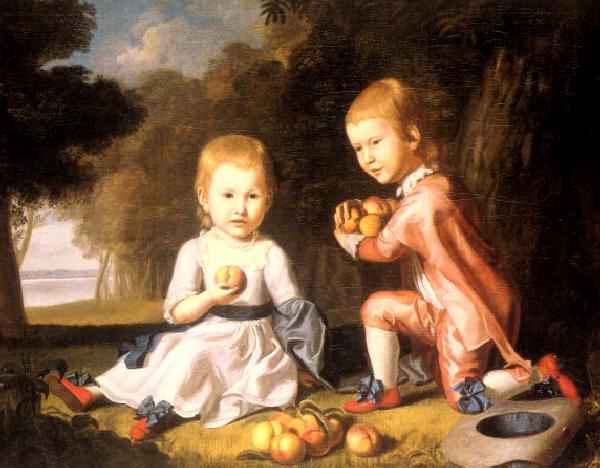
Charles Wilson Peale (United States, 1741-1827)

Figure 1.-- Charles Wilson Peale traveled widely in the middle colonies, developing a reputation as a highly skilled portratist. He painted portraits of numerous colonial officials and important merchants. He did his first portrait of Gerorge Washington (1772). The portrait of the "Stewart Children" may have been made during this period, although I do not have details at this time.
|
Charles Willson Peale is one of the best known early American artists and
remembered as the "Artist of the American Revolution." He was born in Queen Anne's County, Maryland in 1741. He came to Annapolis at the age 9 to apprentice to a local saddler. He received no actual art training and taught himself to paint by watching portraitist John Hesselius work. He observed John Singleton Copley on a visit to Boston. At this time he began to get commissions for portraits from the the Annapolis gentry. We note a painting of the Stewart children which we believe was done by him, probably in the 1770s.
Parents
Childhood
Charles Willson Peale is one of the best known early American artists. He was born in Queen Anne's County, Maryland in 1741.
Education
He came to Annapolis at the age 9 to apprentice to a local saddler. As a young man, however, he dedeveloped an interest in painting.
Saddler
He began working as a saddler, but gave it up in 1765 and traveled to Boston to work under John Singleton Copley.
Training
He received no actual art training and taught himself to paint by watching portraitist John Hesselius work. He observed John Singleton Copley on a visit to Boston. At this time he began to get commissions for portraits from the the Annapolis gentry. Friends financed a trip to London to study under
Benjamin West (1767). West was the first American painter to rise to international prominence. He lead an astonishing life that led him from the American backwoods to the English Royal Academy and genrerously accepted Peale in his studio. While working under West's direction, Peale did two full-length portraits of William Pitt. Peale had a deeply inquisative mind. While in London he experimented with different media, including minatures and mezzotint.
Career
Peale returned to America and set up a studio in Annapolis (1769). He traveled widely in the middle colonies, developing a reputation as a highly skilled portratist. He painted portraits of numerous colonial officials and important merchants. He did his first portrait of Gerorge Washington (1772). The portrait of the "Stewart Children" may have been made during this period, although I do not have details at this time.
Peale moved to Philadelphia at the height of the agitation for independence (1775). He was an ardent patriot and joined the city militia. He rose to the rank of first lieutenant and marched to the fighting front in December of 1776, at a time when the patriot cause seemed lost. He crossed the Delaware River from Trenton into Pennsylvania as the retreating remnants of Washington's Continental army arrived on the river bank. Peale served on a various revolutionary committees in Philadelphia and in the Pennsylvania General Assembly. He did many portratraits including severl of Washington, the lasr completed at the end of his presidency (1795).
Museum
Peale attempted to make a pictorial record of the Revolution. He established Peale's Museum in Independence Hall to display the portraits he made during the war (1802). He is best rememvered as "the artist of the American Revolution". His museum is one of the first art museums in America. He continued to paint, but became increasingly interested in natuaral history. Exhibits of stuffed animals and fossils accompanied his paintings in his museum. He was especially proud of two mastodon skeletons that he dug up and assembled.
Style
Eeflecting his time in London with West, he painted his portraits in the formal English style with background and clothing designed to enphasize social distinctions. He was an accomplisted, but not great portratist. His reputation comes primarily from his portraits of important men of the time--especially Washington.
Family
His children who he named after artists became artists. They included: Raphaelle (1774-1825), Rembrandt (1778-1860), Rubens (1784-1865), and Titian Ramsay (1799-1885). Niece Sarah Miriam Peale (1800-1885) and nephew Charles Peale Polk (1767-1866) also became artists.
HBC

Navigate the Boys' Historical Clothing artistic pages:
[Return to the Main American art page]
[Return to the Main artistic page]
[Chronologies]
[Individuals]
[National]
[Styles]
Navigate the Boys' Historical Clothing Web Site:
[Return to the Main American page]
[Introduction]
[Activities]
[Biographies]
[Chronology]
[Clothing styles]
[Countries]
[Bibliographies]
[Contributions]
[FAQs]
[Glossaries]
[Satellite sites]
[Tools]
[Boys' Clothing Home]
Created: September 25, 2003
Last updated: September 25, 2003



